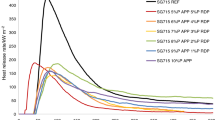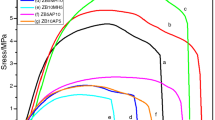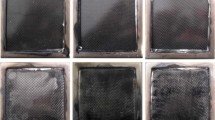Abstract
This study investigates the effects of nanoclay on the mechanical properties and fire performance of epoxy/ glass fibre composites. The cone calorimeter test in a horizontal configuration is used as the bench-scale test to determine the heat and smoke production from samples with nanoclay contents ranging from 1 to 5 wt%. All the samples are produced by a vacuum infusion process. Pristine nanoclay is treated with an organic surfactant before adding it to the mixture in the designed procedure. The results show that a low percentage of less than 3 wt% nanoclay produces a scattered nanoparticle dispersion and, therefore, is insufficient for char formation. The combustion of the organic surfactant in nanoclay and the polymeric resin also outperform the effect of nanoclay at this level. At 5 wt% nanoclay replacement, a delay of 7 s in heat release rate, 45 % lower peak of heat release rate, 15 % lower total heat release, and 15 % lower smoke production rate are observed. Scanning electron microscopy (SEM) images of the samples with varied organophilic clay concentration taken before and after the cone tests are presented to reveal the distribution of clay nanoparticles in the composite samples. The mechanical properties such as ultimate strength, Young’s modulus of the nanoclay-enhanced composite are acquired from standard tensile test to determine the influences of clay content.
Similar content being viewed by others
References
Crossley R., Schubel P., Stevenson A.: Furan matrix and flax fibre as a sustainable renewable composite: mechanical and fire-resistant properties in comparison to phenol, epoxy and polyester. J. Reinf. Plast. Compos. 33(1), 58–68 (2014)
Duflou J.R., Deng Y., Van Acker K., Dewulf W.: Do fiber-reinforced polymer composites provide environmentally benign alternatives? A life-cycle-assessment-based study. MRS Bull. 37(4), 374–382 (2012)
Nguyen Q.T., Ngo T.D., Mendis P., Tran P.: Composite materials for the next generation building facade systems. Civil Eng. Arch. 1(3), 88–95 (2013)
Pendhari S.S., Kant T., Desai Y.M.: Application of polymer composites in civil construction: a general review. Compos. Struct. 84(2), 114–124 (2008)
Faruqi M.A., Escobedo G., Sun D., Sai J.: Research and design guidelines for the construction of fiber-reinforced polymer reinforced concrete structures under fire exposure: a brief review. J. Reinf. Plast. Compos. 32(17), 1302–1309 (2013)
Gibson A.G., Wright P.N.H., Wu Y.S., Mouritz A.P., Mathys Z., Gardiner C.P.: The integrity of polymer composites during and after fire. J. Compos. Mater. 38(15), 1283–1307 (2004)
Katancic Z., Krehula L.K., Sirocic A.P., Grozdanic V., Hrnjak-Murgic Z.: Effect of modified nanofillers on fire retarded high-density polyethylene/wood composites. J. Compos. Mater. 48(30), 3771–3783 (2014)
Wei X.D., Vaucorbeil A.de, Tran P., Espinosa H.D.: A new rate-dependent unidirectional composite model - Application to panels subjected to underwater blast. J. Mech. Phys. Solids 61(6), 1305–1318 (2013)
Liu Y., Deng C.L., Zhao J., Wang J.S., Chen L., Wang Y.Z.: An efficiently halogen-free flame-retardant long-glass-fiber-reinforced polypropylene system. Polym. Degrad. Stab. 96(3), 363–370 (2011)
Nguyen Q.T., Ngo T.D., Tran P., Mendis P., Bhattacharyya D.: Influences of clay and manufacturing on fire resistance of organoclay/thermoset nanocomposites. Compos. Part A Appl. Sci. Manuf. 74, 26–37 (2015)
Nguyen Q.T., Tran P., Ngo T.D., Tran P.A., Mendis P.: Experimental and computational investigations on fire resistance of GFRP composite for building facade. Compos. Part B Eng. 62, 218–229 (2014)
Al-Saidy A.H., Klaiber F.W., Wipf T.J.: Strengthening of steel–concrete composite girders using carbon fiber reinforced polymer plates. Constr. Build. Mater. 21(2), 295–302 (2007)
Feo L., Mosallam A.S., Penna R.: Mechanical behavior of web–flange junctions of thin-walled pultruded I-profiles: An experimental and numerical evaluation. Compos. Part B Eng. 48, 18–39 (2013)
Uomoto T., Mutsuyoshi H., Katsuki F., Misra S.: Use of fiber reinforced polymer composites as reinforcing material for concrete. J. Mater. Civil Eng. 14(3), 191–209 (2002)
Ghazlan A., Ngo T.D., Tran P.: Influence of interfacial geometry on the energy absorption capacity and load sharing mechanisms of nacreous composite shells. Compos. Struct. 132, 299–309 (2015)
Tran P., Ngo T.D., Mendis P.: Bio-inspired composite structures subjected to underwater impulsive loading. Comput. Mater. Sci. 82, 134–139 (2014)
Yang C., Tran P., Ngo T., Mendis P., Humphries W.: Effect of Textile Architecture on Energy Absorption of Woven Fabrics Subjected to Ballistic Impact. Appl. Mech. Mater. 553, 757–762 (2014)
Dahiya J.B., Kandola B.K., Sitpalan A., Horrocks A.R.: Effects of nanoparticles on the flame retardancy of the ammonium sulphamate-dipentaerythritol flame-retardant system in polyamide 6. Polym. Adv. Tech. 24(4), 398–406 (2013)
Huang G.B., Yang J.G., Wang X., Gao J.R.: Nanoclay, intumescent flame retardants, and their combination with chemical modification for the improvement of the flame retardant properties of polymer nanocomposites. Macromol. Res. 21(1), 27–34 (2013)
Thirumal M., Khastgir D., Singha N.K., Manjunath B.S., Naik Y.P.: Effect of a Nanoclay on the Mechanical, Thermal and Flame Retardant Properties of Rigid Polyurethane Foam. J. Macromol. Sci. Part A Pure Appl. Chem. 46(7), 704–712 (2009)
Beyer G.: Flame retardancy of nanocomposites-from research to technical products. J. Fire Sci. 23(1), 75–87 (2005)
Dabrowski F., Le Bras M., Delobel R., Gilman J.W., Kashiwagi T.: Using clay in PA-based intumescent formulations. Fire performance and kinetic parameters. Macromol. Symposia 194(1), 201–206 (2003)
Gilman J.W.: Flammability and thermal stability studies of polymer layered-silicate (clay) nanocomposites. Appl. Clay Sci. 15(1–2), 31–49 (1999)
Gilman J.W., Lomakin S., Kashiwagi T., VanderHart D.L., Nagy V.: Characterization of flame-retarded polymer combustion chars by solid-state 13C and 29Si NMR and EPR. Fire Mater. 22(2), 61–67 (1998)
Gilman J.W., Ritchie S.J., Kashiwagi T., Lomakin S.M.: Fire-retardant additives for polymeric materials—I Char formation from silica gel–potassium carbonate. Fire Mater. 21(1), 23–32 (1997)
Liu T., Ping Lim K., Chauhari Tjiu W., Pramoda K.P., Chen Z.-K.: Preparation and characterization of nylon 11/organoclay nanocomposites. Polymer 44(12), 3529–3535 (2003)
Morgan A.B.: Flame retarded polymer layered silicate nanocomposites: a review of commercial and open literature systems. Polym. Adv. Tech. 17(4), 206–217 (2006)
Morgan A.B., Harris R.H., Kashiwagi T., Chyall L.J., Gilman J.W.: Flammability of polystyrene layered silicate (clay) nanocomposites: Carbonaceous char formation. Fire Mater. 26(6), 247–253 (2002)
Shi Y., Kashiwagi T., Walters R.N., Gilman J.W., Lyon R.E., Sogah D.Y.: Ethylene vinyl acetate/layered silicate nanocomposites prepared by a surfactant-free method: Enhanced flame retardant and mechanical properties. Polymer 50(15), 3478–3487 (2009)
Shi, L.; Chew, M.Y.L.: Fire behaviors of polymers under autoignition conditions in a cone calorimeter. Fire Safety Journal 61, 243–253 (2013)
Gintert M.J., Jana S.C., Miller S.G.: A novel strategy for nanoclay exfoliation in thermoset polyimide nanocomposite systems. Polymer 48(14), 4166–4173 (2007)
Author information
Authors and Affiliations
Corresponding author
Rights and permissions
About this article
Cite this article
Ngo, T.D., Nguyen, Q.T., Nguyen, T.P. et al. Effect of Nanoclay on Thermomechanical Properties of Epoxy/Glass Fibre Composites. Arab J Sci Eng 41, 1251–1261 (2016). https://doi.org/10.1007/s13369-015-1898-0
Received:
Accepted:
Published:
Issue Date:
DOI: https://doi.org/10.1007/s13369-015-1898-0




